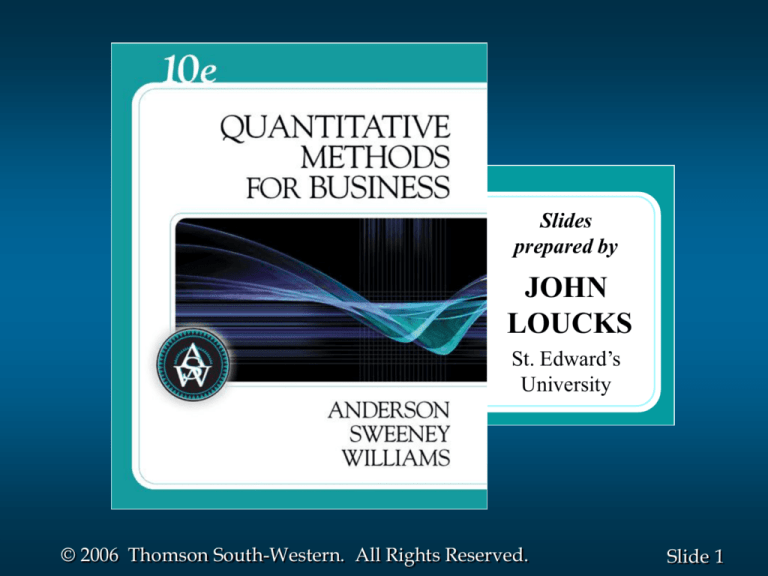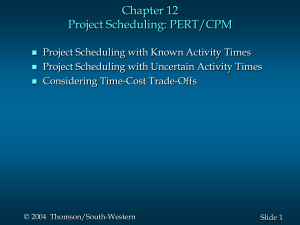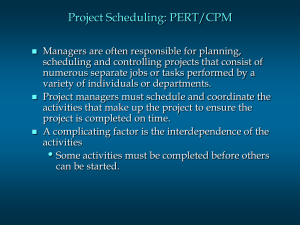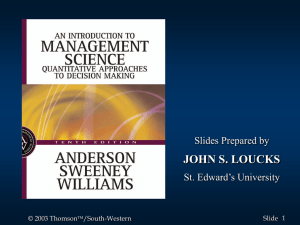
Slides
prepared by
JOHN
LOUCKS
St. Edward’s
University
© 2006 Thomson South-Western. All Rights Reserved.
Slide 1
Chapter 12
Project Scheduling: PERT/CPM
Project Scheduling with Known Activity Times
Project Scheduling with Uncertain Activity Times
Considering Time-Cost Trade-Offs
© 2006 Thomson South-Western. All Rights Reserved.
Slide 2
PERT/CPM
PERT
• Program Evaluation and Review Technique
• Developed by U.S. Navy for Polaris missile project
• Developed to handle uncertain activity times
CPM
• Critical Path Method
• Developed by Du Pont & Remington Rand
• Developed for industrial projects for which activity
times generally were known
Today’s project management software packages have
combined the best features of both approaches.
© 2006 Thomson South-Western. All Rights Reserved.
Slide 3
PERT/CPM
PERT and CPM have been used to plan, schedule, and
control a wide variety of projects:
• R&D of new products and processes
• Construction of buildings and highways
• Maintenance of large and complex equipment
• Design and installation of new systems
© 2006 Thomson South-Western. All Rights Reserved.
Slide 4
PERT/CPM
PERT/CPM is used to plan the scheduling of
individual activities that make up a project.
Projects may have as many as several thousand
activities.
A complicating factor in carrying out the activities is
that some activities depend on the completion of other
activities before they can be started.
© 2006 Thomson South-Western. All Rights Reserved.
Slide 5
PERT/CPM
Project managers rely on PERT/CPM to help them
answer questions such as:
• What is the total time to complete the project?
• What are the scheduled start and finish dates for each
specific activity?
• Which activities are critical and must be completed
exactly as scheduled to keep the project on schedule?
• How long can noncritical activities be delayed before
they cause an increase in the project completion time?
© 2006 Thomson South-Western. All Rights Reserved.
Slide 6
Project Network
A project network can be constructed to model the
precedence of the activities.
The nodes of the network represent the activities.
The arcs of the network reflect the precedence
relationships of the activities.
A critical path for the network is a path consisting of
activities with zero slack.
© 2006 Thomson South-Western. All Rights Reserved.
Slide 7
Example: Frank’s Fine Floats
Frank’s Fine Floats is in the business of building
elaborate parade floats. Frank and his crew have a
new float to build and want to use PERT/CPM to help
them manage the project .
The table on the next slide shows the activities
that comprise the project. Each activity’s estimated
completion time (in days) and immediate predecessors
are listed as well.
Frank wants to know the total time to complete
the project, which activities are critical, and the earliest
and latest start and finish dates for each activity.
© 2006 Thomson South-Western. All Rights Reserved.
Slide 8
Example: Frank’s Fine Floats
Immediate
Activity Description
Predecessors
A
Initial Paperwork
--B
Build Body
A
C
Build Frame
A
D
Finish Body
B
E
Finish Frame
C
F
Final Paperwork
B,C
G
Mount Body to Frame D,E
H
Install Skirt on Frame
C
© 2006 Thomson South-Western. All Rights Reserved.
Completion
Time (days)
3
3
2
3
7
3
6
2
Slide 9
Example: Frank’s Fine Floats
Project Network
Start
B
D
3
3
G
F
6
A
3
3
E
C
7
Finish
H
2
© 2006 Thomson South-Western. All Rights Reserved.
2
Slide 10
Earliest Start and Finish Times
Step 1: Make a forward pass through the network as
follows: For each activity i beginning at the Start
node, compute:
• Earliest Start Time = the maximum of the earliest
finish times of all activities immediately preceding
activity i. (This is 0 for an activity with no
predecessors.)
• Earliest Finish Time = (Earliest Start Time) +
(Time to complete activity i ).
The project completion time is the maximum of the
Earliest Finish Times at the Finish node.
© 2006 Thomson South-Western. All Rights Reserved.
Slide 11
Example: Frank’s Fine Floats
Earliest Start and Finish Times
B
3 6
D
3
3
F
Start
A
6 9
G
6 9
12 18
6
3
0 3
3
E
C
3 5
7
Finish
5 12
H
2
© 2006 Thomson South-Western. All Rights Reserved.
5 7
2
Slide 12
Latest Start and Finish Times
Step 2: Make a backwards pass through the network
as follows: Move sequentially backwards from the
Finish node to the Start node. At a given node, j,
consider all activities ending at node j. For each of
these activities, i, compute:
• Latest Finish Time = the minimum of the latest
start times beginning at node j. (For node N, this
is the project completion time.)
• Latest Start Time = (Latest Finish Time) - (Time to
complete activity i ).
© 2006 Thomson South-Western. All Rights Reserved.
Slide 13
Example: Frank’s Fine Floats
Latest Start and Finish Times
B
3 6
3 6 9
Start
D
6 9
3 9 12
G
F
6 12 18
6 9
A
0 3
3 15 18
3
0 3
E
C
3 5
12 18
Finish
5 12
7 5 12
H
2 3 5
© 2006 Thomson South-Western. All Rights Reserved.
5 7
2 16 18
Slide 14
Determining the Critical Path
Step 3: Calculate the slack time for each activity by:
Slack = (Latest Start) - (Earliest Start), or
= (Latest Finish) - (Earliest Finish).
© 2006 Thomson South-Western. All Rights Reserved.
Slide 15
Example: Frank’s Fine Floats
Activity Slack Time
Activity ES EF
A
0
3
B
3
6
C
3
5
D
6
9
E
5 12
F
6
9
G
12 18
H
5
7
LS
0
6
3
9
5
15
12
16
LF Slack
3
0 (critical)
9
3
5
0 (critical)
12
3
12
0 (critical)
18
9
18
0 (critical)
18
11
© 2006 Thomson South-Western. All Rights Reserved.
Slide 16
Example: Frank’s Fine Floats
Determining the Critical Path
• A critical path is a path of activities, from the Start
node to the Finish node, with 0 slack times.
• Critical Path:
A–C–E–G
• The project completion time equals the maximum of
the activities’ earliest finish times.
• Project Completion Time:
18 days
© 2006 Thomson South-Western. All Rights Reserved.
Slide 17
Example: Frank’s Fine Floats
Critical Path
B
3 6
3 6 9
Start
D
6 9
3 9 12
G
F
6 12 18
6 9
A
0 3
3 15 18
3
0 3
E
C
3 5
12 18
Finish
5 12
7 5 12
H
2 3 5
© 2006 Thomson South-Western. All Rights Reserved.
5 7
2 16 18
Slide 18
End of Chapter 12
© 2006 Thomson South-Western. All Rights Reserved.
Slide 19










